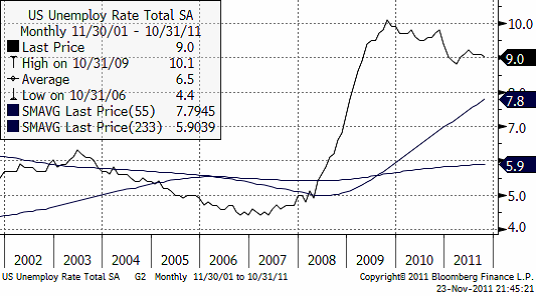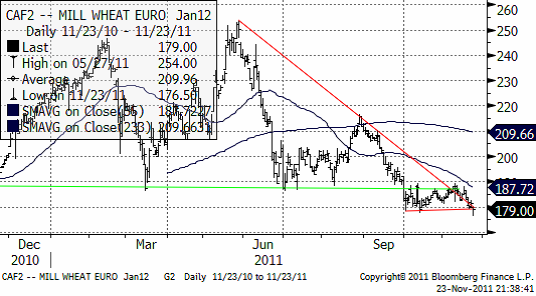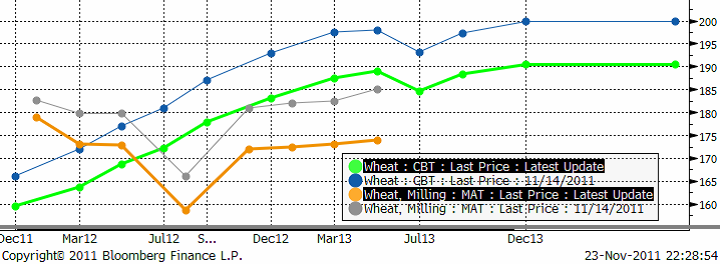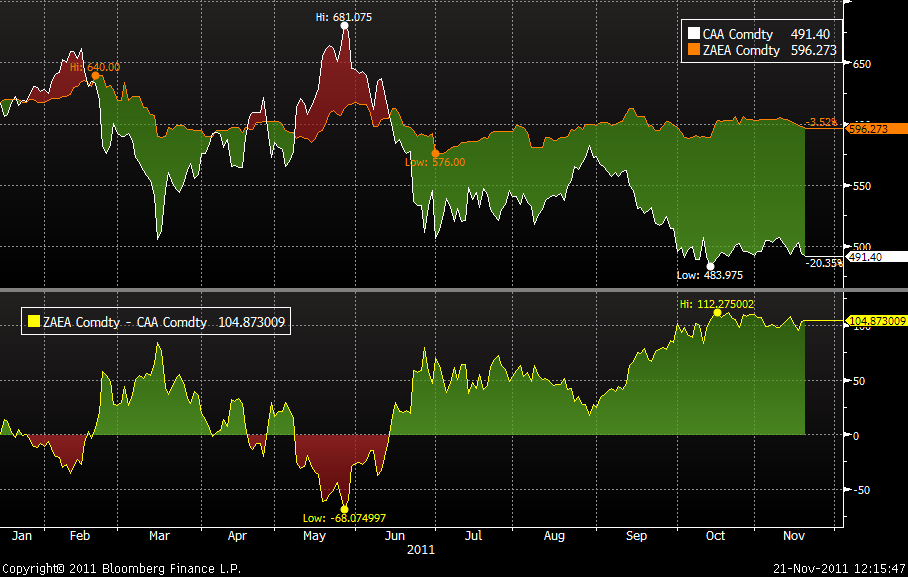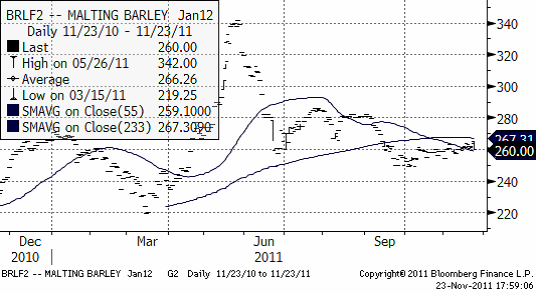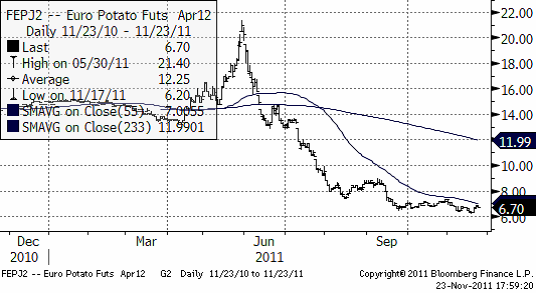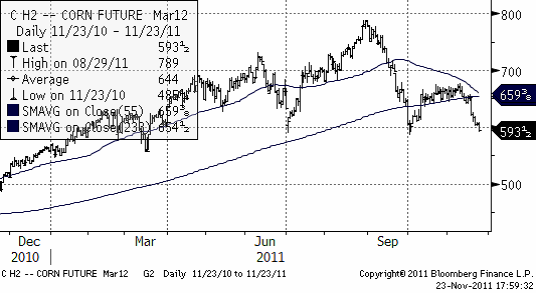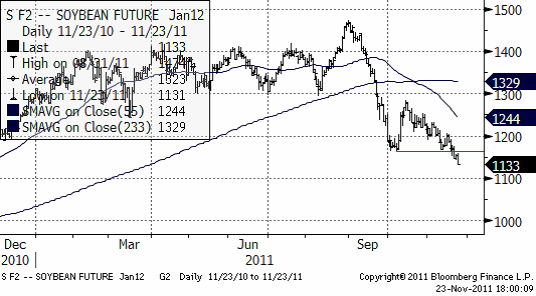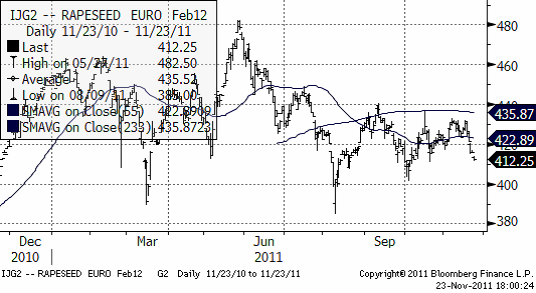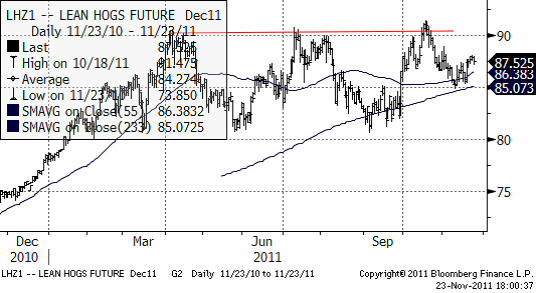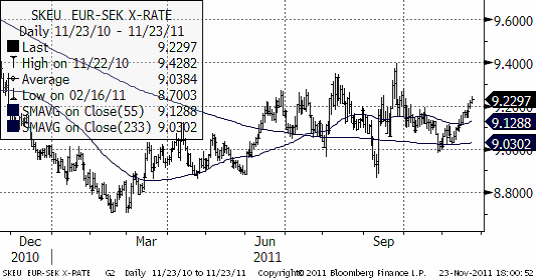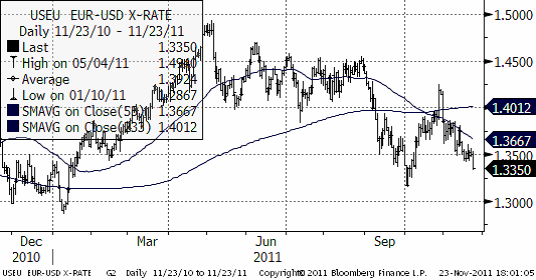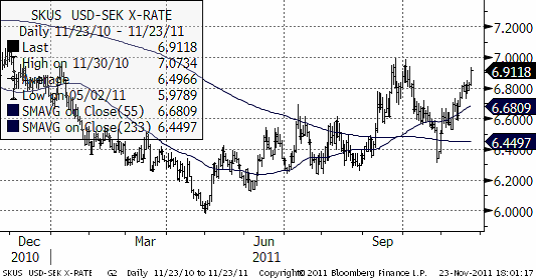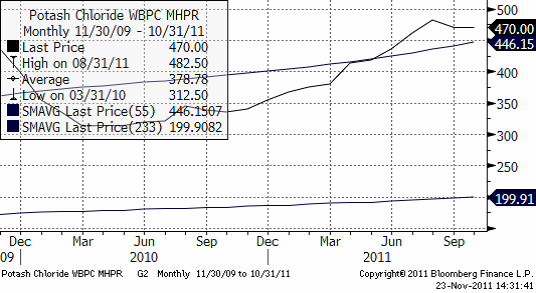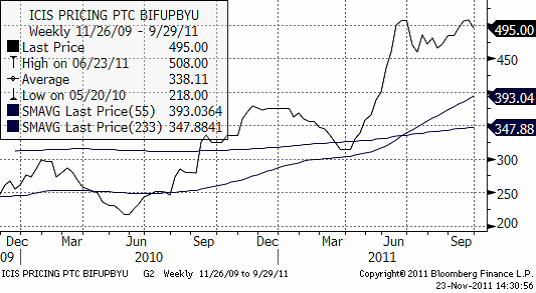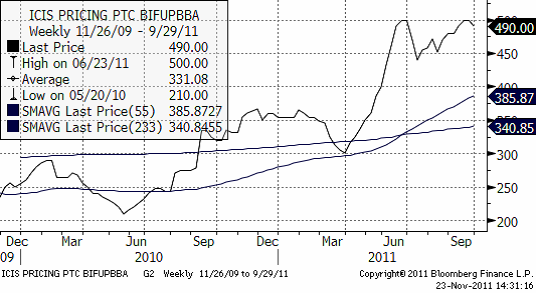Analys
SEB – Jordbruksprodukter, vecka 47
 Vete, majs och sojabönor har precis brutit sina tekniska stöd och noterar prisnedgångar den senaste veckan på mellan 5 och 9%. Omvärlden utanför lantbruksmarknaderna påverkar negativt.
Vete, majs och sojabönor har precis brutit sina tekniska stöd och noterar prisnedgångar den senaste veckan på mellan 5 och 9%. Omvärlden utanför lantbruksmarknaderna påverkar negativt.
HSBC:s så kallade ”flash PMI” för Kina hamnade på 48.3 i tisdags. PMI är ett mått på inköpschefernas aktivitet och ett PMI under 50 signalerar en krympande ekonomi. Det officiella PMI publiceras den 1 december, men HSBC:s snabbvariant brukar vara rättvisande.
Från USA kom också en kalldusch när tillväxten i bruttonationalprodukten för det andra kvartalet justerades ner från +2.5% till +2.0%. Fruktan sprider sig att USA ska gå in i en ny lågkonjunktur samtidigt som skulderna är ”olagligt höga” och växer utan att politikerna tycks kunna enas om att kontrollera dem. Staten borde spara, men tillväxten bromsas redan och arbetslösheten ligger på 9%. Nedan ser vi arbetslösheten i USA de senaste 10 åren.
USA är stängt för Thanksgiving idag torsdag och fredagen är en klämdag, den så kallade ”Black Friday”, som inte har med marknaden att göra utan är en rea-dag i detaljhandeln. Marknaden kommer att vara tunn. Ofta sker stora och betydelsefulla rörelser under sådana tillfällen, så man bör hålla en extra koll på marknaderna idag och imorgon.
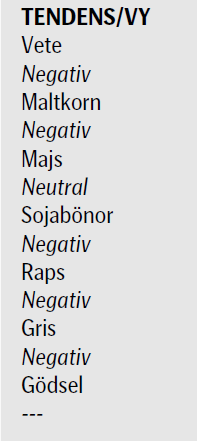 Europa ser inte bättre ut. Tyskland hade tänkt emittera nya obligationer igår, men mer än en tredjedel av dem blev kvar. Det berodde inte på att priset blev fel. Spararna var helt enkelt ointresserade. Under tiden ligger Italiens 10-årsränta kvar på samma höga nivå som före premiärministerbytet, Frankrikes ränta fortsätter stiga och Spaniens (”too big to save”) steg igår till 6.65%. Greklands ränta går inte att hitta längre i Bloomberg. ”Return on capital” är uppenbarligen ointressant. Det som visas är priset på statspapperen (lite drygt 20%), alltså ”return of capital”.
Europa ser inte bättre ut. Tyskland hade tänkt emittera nya obligationer igår, men mer än en tredjedel av dem blev kvar. Det berodde inte på att priset blev fel. Spararna var helt enkelt ointresserade. Under tiden ligger Italiens 10-årsränta kvar på samma höga nivå som före premiärministerbytet, Frankrikes ränta fortsätter stiga och Spaniens (”too big to save”) steg igår till 6.65%. Greklands ränta går inte att hitta längre i Bloomberg. ”Return on capital” är uppenbarligen ointressant. Det som visas är priset på statspapperen (lite drygt 20%), alltså ”return of capital”.
Ska vi sammanfatta, så ser det illavarslande ut. Konsumtionen ser ut att drabbas i USA, i Europa och i Kina. Om vi drar paralleller till 2008/09, så skulle vi kunna vänta oss att privat konsumtion håller i sig till Jul och sedan blir det tvärstopp. Jag kanske låter negativ, men situationen är verkligen mycket, mycket allvarlig i samhällshushållningen utanför jordbruksmarknaden.
Vete
Terminspriset på Matif-vete stängde på 179 euro för februarileverans. Som väntat har inte 180-euronivån hållit. Marknaden handlade under dagen ner vetet till 176.5 euro, men fyndköpare kom in och stängde onsdagen på 179. Detta är ändå en klar säljsignal.
Nedan ser vi terminskurvan för Chicagovete och Matif nu och för en vecka sedan. De ”feta” kurvorna är de aktuella. De ”smala” är förra veckans. Vi ser något av en tendens till särskilt lägre priser på längre Matif-terminer.
Förra gången vi såg backwardation i Europa var förra gången (2008) som priset föll. Då visade det sig att bönder satt kvar med vetet på gården i förhoppningen om att kunna sälja det dyrare – om bara priset ville gå upp igen. Kanske är det samma orsak till backwardation igen (brist, för att bönder inte säljer).
Om bönderna tror på högre priser och sitter kvar med vetet – sälj åtminstone spot dyrt och köp terminer billigare istället. Det är bättre. Men inte bra. Det här är en riktig ”bear market”. Priset kommer att falla. Det är ett klassiskt fall av rekommendationen ”Sell and go away. Come back in May.”
Etanol har blivit en viktig faktor, inte bara för majs i USA, utan även för vete i Europa. Europa och USA är två ganska osynkroniserade marknader. Skatter, tullar, kvoter och transportkostnader skapar ett samband i USA mellan majs och etanol och i Europa mellan vete och etanol. När foderefterfrågan kan väntas dämpas i Europa pga minskad konsumtion och ökat sparande, står etanoltillverkarnas efterfrågan på spannmål kvar som en viktig faktor.
Matif-kvarnvete vs Etanolsorten T2 FOB Rotterdam ser vi i diagrammet nedan. Just nu kostar vetet till ett ton etanol 491 euro och ett ton etanol 596, FOB Rotterdam. Marginalen är alltså 104 euro per ton etanol.
Som vi ser är detta en historiskt mycket god marginal. Etanolproducenternas intressen är alltså ett stöd i marknaden. Men notera att marginalen vi ser ovan inte är etanolproducenternas vinst. Kostnaderna utgörs även av bränsle, löner, räntor och avskrivningar, förstås.
Råoljepriset hålls högt – och extremt volatilt – eftersom produktionsreserverna (som kan tas i anspråk vid behov) är små. Så har det varit sedan ungefär 2005. Å ena sidan tycks vi stå inför en konjunkturnedgång. Å andra sidan befinner sig Syrien och Egypten i uppror i den rörelse som kallas ”den arabiska våren” och som skapar oro för att de små reserverna i oljeproduktionen inte ska räcka till om ett viktigare land än Libyen drabbas av krig.
Ryssland och Ukraina fortsätter att vinna exportordrar. Och europeiskt vete fortsätter att förlora tenders. I fredags förra veckan nåddes vi av det obekräftade ryktet att Algeriet (som köpt 100% från Frankrike alla år) köpt Argentinskt. Det finns ännu inga tecken på att Ryssland och Ukraina nått ”peak exports” för säsongen.
Allt talar för att Matif-vete faller ner i första hand till 150 – 160 – euro-nivån. På köparsidan hittar vi antagligen etanolfabrikanter.
Maltkorn
Maltkornsmarknaden följer vetet och det finns inga speciella nyheter att rapportera. Tekniskt ligger priset under glidande medelvärden. Den tekniska trenden är alltså nedåtriktad.
Potatis
Priset på potatis av årets skörd steg med 5% den senaste veckan, som en reaktion på förra veckans prisfall på 9%.
Nedan ser vi kursdiagrammet på europeisk potatis, som handlas på Eurex; terminen avser leverans april nästa år.
Majs
Majspriset har fallit till en teknisk stödnivå och frågan är nu om priset kommer att brytas. Vad som direkt talar för det är att dollarn har stärkts kraftigt mot europeiska valutor. Bara av den anledningen borde priset (i dollar) justeras ner.
I Argentina sker sådden just nu och det är relativt torrt. En förvärring av La Niña vore ”bullish news”, men den närmaste 14-dagarsprognosen innehåller en del regn, så än så länge ligger farhågorna i framtiden.
Nedan ser vi marskontraktet på CBOT, där priset ligger på den nivå vid 600 cent där marknaden funnit stöd flera gånger. Den här gången talar dock den starka dollarn för att stödet bryts och majs definitivt går in i en ”bear market”.
Sojabönor
Priset på sojabönor befinner sig i en sjunkande trend. Det är en ”bear market”. Denna förstärktes för ett par dagar sedan när det tekniska stödet på 1167 bröts. Priset kan mycket väl gå ner mot 10 dollar.
Brasilianska säljare lär komma in allt mer och sälja ner priset. Vi är negativa ur tekniskt perspektiv de närmaste tre månaderna.
Raps
Rapspriset håller sig högt pga den svaga euron, inget annat, skrev vi för en vecka sedan och det gäller än. Raps är dyrt i förhållande till sojabönor och ”borde” falla ner mot 400 euro i första hand.
Gris
Tekniskt vilar priset på lean hogs på de glidande medelvärdena. Priset håller sig högt, trots svaghet i alla andra marknader utom ädelmetaller. Det är orimligt och priset på gris borde gå ner det också.
Valutor
EURSEK handlas i ett volatilt brett intervall. Det finns inga signaler att utläsa alls. Kronan har försvagats och det är konstigt.
EURUSD har äntligen brutit nedåt och nu lär det gå fort.l. I första hand är nästa stöd 1.3145 dollar. I andra hand är det botten nere vid 1.2 dollar.
USDSEK stiger som förväntat när det skakar till i världen och lite extra förstås när det skakar till i EU (som Sverige är en del av). Nästa test är 7 kr och med det momentum marknaden har är valutakursen sannolikt där snart.
Gödsel
Kalium
Priset på kalium ligger kvar på samma nivå som för ett par veckor sedan.
Kväve
Nedan ser vi prisutvecklingen på Urea FOB Yuzhny i dollar per ton. Det har inte varit någon förändring.
Fosfor
Nedan ser vi prisutvecklingen på Diammoniumfosfat FOB Baltic i dollar per ton. Det har inte varit någon förändring från förra veckan.
[box]SEB Veckobrev Jordbruksprodukter är producerat av SEB Merchant Banking och publiceras i samarbete och med tillstånd på Råvarumarknaden.se[/box]
Disclaimer
The information in this document has been compiled by SEB Merchant Banking, a division within Skandinaviska Enskilda Banken AB (publ) (“SEB”).
Opinions contained in this report represent the bank’s present opinion only and are subject to change without notice. All information contained in this report has been compiled in good faith from sources believed to be reliable. However, no representation or warranty, expressed or implied, is made with respect to the completeness or accuracy of its contents and the information is not to be relied upon as authoritative. Anyone considering taking actions based upon the content of this document is urged to base his or her investment decisions upon such investigations as he or she deems necessary. This document is being provided as information only, and no specific actions are being solicited as a result of it; to the extent permitted by law, no liability whatsoever is accepted for any direct or consequential loss arising from use of this document or its contents.
About SEB
SEB is a public company incorporated in Stockholm, Sweden, with limited liability. It is a participant at major Nordic and other European Regulated Markets and Multilateral Trading Facilities (as well as some non-European equivalent markets) for trading in financial instruments, such as markets operated by NASDAQ OMX, NYSE Euronext, London Stock Exchange, Deutsche Börse, Swiss Exchanges, Turquoise and Chi-X. SEB is authorized and regulated by Finansinspektionen in Sweden; it is authorized and subject to limited regulation by the Financial Services Authority for the conduct of designated investment business in the UK, and is subject to the provisions of relevant regulators in all other jurisdictions where SEB conducts operations. SEB Merchant Banking. All rights reserved.
Analys
Tightening fundamentals – bullish inventories from DOE

The latest weekly report from the US DOE showed a substantial drawdown across key petroleum categories, adding more upside potential to the fundamental picture.

Commercial crude inventories (excl. SPR) fell by 5.8 million barrels, bringing total inventories down to 415.1 million barrels. Now sitting 11% below the five-year seasonal norm and placed in the lowest 2015-2022 range (see picture below).
Product inventories also tightened further last week. Gasoline inventories declined by 2.1 million barrels, with reductions seen in both finished gasoline and blending components. Current gasoline levels are about 3% below the five-year average for this time of year.
Among products, the most notable move came in diesel, where inventories dropped by almost 4.1 million barrels, deepening the deficit to around 20% below seasonal norms – continuing to underscore the persistent supply tightness in diesel markets.
The only area of inventory growth was in propane/propylene, which posted a significant 5.1-million-barrel build and now stands 9% above the five-year average.
Total commercial petroleum inventories (crude plus refined products) declined by 4.2 million barrels on the week, reinforcing the overall tightening of US crude and products.


Analys
Bombs to ”ceasefire” in hours – Brent below $70

A classic case of “buy the rumor, sell the news” played out in oil markets, as Brent crude has dropped sharply – down nearly USD 10 per barrel since yesterday evening – following Iran’s retaliatory strike on a U.S. air base in Qatar. The immediate reaction was: “That was it?” The strike followed a carefully calibrated, non-escalatory playbook, avoiding direct threats to energy infrastructure or disruption of shipping through the Strait of Hormuz – thus calming worst-case fears.

After Monday morning’s sharp spike to USD 81.4 per barrel, triggered by the U.S. bombing of Iranian nuclear facilities, oil prices drifted sideways in anticipation of a potential Iranian response. That response came with advance warning and caused limited physical damage. Early this morning, both the U.S. President and Iranian state media announced a ceasefire, effectively placing a lid on the immediate conflict risk – at least for now.
As a result, Brent crude has now fallen by a total of USD 12 from Monday’s peak, currently trading around USD 69 per barrel.
Looking beyond geopolitics, the market will now shift its focus to the upcoming OPEC+ meeting in early July. Saudi Arabia’s decision to increase output earlier this year – despite falling prices – has drawn renewed attention considering recent developments. Some suggest this was a response to U.S. pressure to offset potential Iranian supply losses.
However, consensus is that the move was driven more by internal OPEC+ dynamics. After years of curbing production to support prices, Riyadh had grown frustrated with quota-busting by several members (notably Kazakhstan). With Saudi Arabia cutting up to 2 million barrels per day – roughly 2% of global supply – returns were diminishing, and the risk of losing market share was rising. The production increase is widely seen as an effort to reassert leadership and restore discipline within the group.
That said, the FT recently stated that, the Saudis remain wary of past missteps. In 2018, Riyadh ramped up output at Trump’s request ahead of Iran sanctions, only to see prices collapse when the U.S. granted broad waivers – triggering oversupply. Officials have reportedly made it clear they don’t intend to repeat that mistake.
The recent visit by President Trump to Saudi Arabia, which included agreements on AI, defense, and nuclear cooperation, suggests a broader strategic alignment. This has fueled speculation about a quiet “pump-for-politics” deal behind recent production moves.
Looking ahead, oil prices have now retraced the entire rally sparked by the June 13 Israel–Iran escalation. This retreat provides more political and policy space for both the U.S. and Saudi Arabia. Specifically, it makes it easier for Riyadh to scale back its three recent production hikes of 411,000 barrels each, potentially returning to more moderate increases of 137,000 barrels for August and September.
In short: with no major loss of Iranian supply to the market, OPEC+ – led by Saudi Arabia – no longer needs to compensate for a disruption that hasn’t materialized, especially not to please the U.S. at the cost of its own market strategy. As the Saudis themselves have signaled, they are unlikely to repeat previous mistakes.
Conclusion: With Brent now in the high USD 60s, buying oil looks fundamentally justified. The geopolitical premium has deflated, but tensions between Israel and Iran remain unresolved – and the risk of missteps and renewed escalation still lingers. In fact, even this morning, reports have emerged of renewed missile fire despite the declared “truce.” The path forward may be calmer – but it is far from stable.
Analys
A muted price reaction. Market looks relaxed, but it is still on edge waiting for what Iran will do

Brent crossed the 80-line this morning but quickly fell back assigning limited probability for Iran choosing to close the Strait of Hormuz. Brent traded in a range of USD 70.56 – 79.04/b last week as the market fluctuated between ”Iran wants a deal” and ”US is about to attack Iran”. At the end of the week though, Donald Trump managed to convince markets (and probably also Iran) that he would make a decision within two weeks. I.e. no imminent attack. Previously when when he has talked about ”making a decision within two weeks” he has often ended up doing nothing in the end. The oil market relaxed as a result and the week ended at USD 77.01/b which is just USD 6/b above the year to date average of USD 71/b.

Brent jumped to USD 81.4/b this morning, the highest since mid-January, but then quickly fell back to a current price of USD 78.2/b which is only up 1.5% versus the close on Friday. As such the market is pricing a fairly low probability that Iran will actually close the Strait of Hormuz. Probably because it will hurt Iranian oil exports as well as the global oil market.
It was however all smoke and mirrors. Deception. The US attacked Iran on Saturday. The attack involved 125 warplanes, submarines and surface warships and 14 bunker buster bombs were dropped on Iranian nuclear sites including Fordow, Natanz and Isfahan. In response the Iranian Parliament voted in support of closing the Strait of Hormuz where some 17 mb of crude and products is transported to the global market every day plus significant volumes of LNG. This is however merely an advise to the Supreme leader Ayatollah Ali Khamenei and the Supreme National Security Council which sits with the final and actual decision.
No supply of oil is lost yet. It is about the risk of Iran closing the Strait of Hormuz or not. So far not a single drop of oil supply has been lost to the global market. The price at the moment is all about the assessed risk of loss of supply. Will Iran choose to choke of the Strait of Hormuz or not? That is the big question. It would be painful for US consumers, for Donald Trump’s voter base, for the global economy but also for Iran and its population which relies on oil exports and income from selling oil out of that Strait as well. As such it is not a no-brainer choice for Iran to close the Strait for oil exports. And looking at the il price this morning it is clear that the oil market doesn’t assign a very high probability of it happening. It is however probably well within the capability of Iran to close the Strait off with rockets, mines, air-drones and possibly sea-drones. Just look at how Ukraine has been able to control and damage the Russian Black Sea fleet.
What to do about the highly enriched uranium which has gone missing? While the US and Israel can celebrate their destruction of Iranian nuclear facilities they are also scratching their heads over what to do with the lost Iranian nuclear material. Iran had 408 kg of highly enriched uranium (IAEA). Almost weapons grade. Enough for some 10 nuclear warheads. It seems to have been transported out of Fordow before the attack this weekend.
The market is still on edge. USD 80-something/b seems sensible while we wait. The oil market reaction to this weekend’s events is very muted so far. The market is still on edge awaiting what Iran will do. Because Iran will do something. But what and when? An oil price of 80-something seems like a sensible level until something do happen.
-

 Nyheter4 veckor sedan
Nyheter4 veckor sedanUppgången i oljepriset planade ut under helgen
-

 Nyheter3 veckor sedan
Nyheter3 veckor sedanMahvie Minerals växlar spår – satsar fullt ut på guld
-

 Nyheter4 veckor sedan
Nyheter4 veckor sedanLåga elpriser i sommar – men mellersta Sverige får en ökning
-

 Nyheter2 veckor sedan
Nyheter2 veckor sedanOljan, guldet och marknadens oroande tystnad
-

 Analys4 veckor sedan
Analys4 veckor sedanVery relaxed at USD 75/b. Risk barometer will likely fluctuate to higher levels with Brent into the 80ies or higher coming 2-3 weeks
-

 Nyheter2 veckor sedan
Nyheter2 veckor sedanJonas Lindvall är tillbaka med ett nytt oljebolag, Perthro, som ska börsnoteras
-

 Analys3 veckor sedan
Analys3 veckor sedanA muted price reaction. Market looks relaxed, but it is still on edge waiting for what Iran will do
-

 Nyheter2 veckor sedan
Nyheter2 veckor sedanDomstolen ger klartecken till Lappland Guldprospektering


